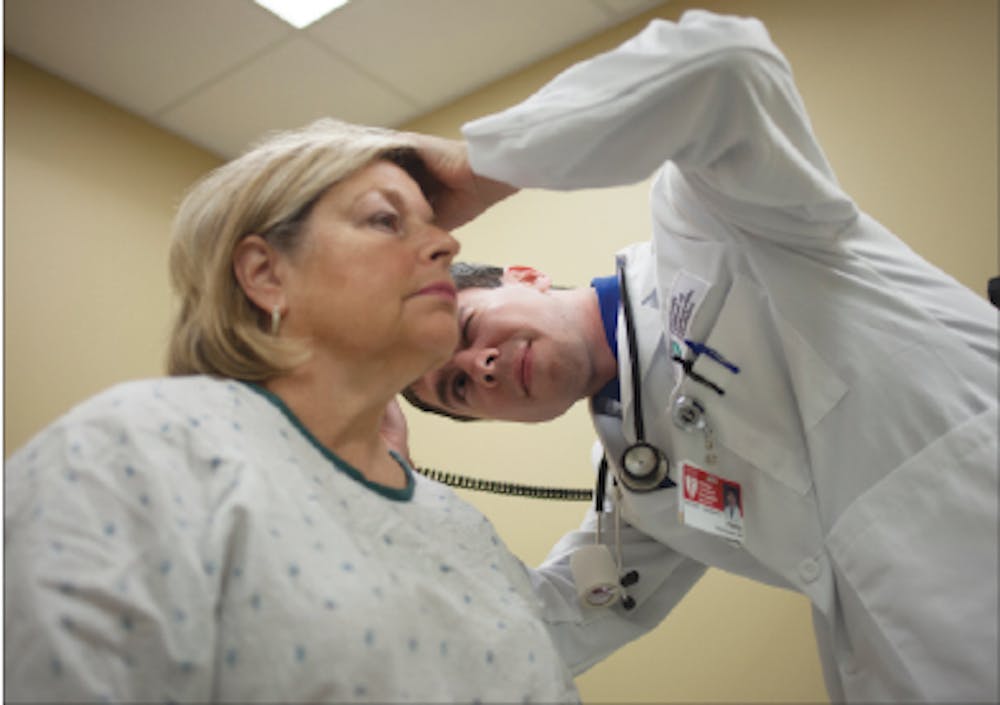HCOM students work with standardized patients who act from a script
Sometimes, medical school requires a bit of acting.
Ohio University’s Heritage College of Osteopathic Medicine’s first and second-year students practice body examinations and basic tests on patients who have a scripted illness or injury.
So this means when a patient — called a standardized patient — arrives to the basement of Grosvenor Hall complaining to a student-doctor about crippling back pain, he or she is actually working from a script.
“The standardized patients are actor patients who are assigned a specific role for a case,” said Kenneth Johnson, dean of HCOM.
Each of the 60 standardized patients receives a script five to seven days before he or she comes in to be examined, said Pam Henderson, clinical training and assessment center supervisor in HCOM.
The patients are paid under contract with HCOM, but they do not receive any benefits or vacation time from OU, Henderson said.
Originally, the standardized patients came to OU from local theaters, Johnson said.
But now, former teachers and nurses are increasingly joining the mix to help contribute to the education of future physicians, Henderson said.
“We try to make a difference in their lives,” said Le-Ann Horton, a standardized patient. “They might remember having a patient who had this (problem), and how to deal with it.”
Patients work from scripts that can vary from common colds to anxiety.
“Some are more fun, and some are just hard,” said Julie Davis, a standardized patient. “For example, you may be getting some bad news that day.”
OU-HCOM makes standardized patients sign a confidentiality agreement which doesn’t allow them to reveal more information about where they’re from, etc.
Labs are offered at different times throughout the day, and the standardized patients may have a different script for each appointment.
“We can be having headaches in the morning and (be) pregnant women in the afternoon,” Davis said. “It’s pretty remarkable.”
Depending on what level the student is, the labs will focus on different skills, Johnson said.
“Early on, these are focused on developing simple communication skills and just finding the right way to talk to patients,” Johnson said. “Usually, this means taking technical language and turning it into everyday language.”
Following the examination, standardized patients evaluate students on their performance, and then the student-doctors receive grades from their professors.
Davis said that although she is not the one being graded for the performance, she often feels nervous during the examinations.
Students and patients are recorded during the examination. Each room is equipped with a video camera so students can go back and watch the assessments.
“The feedback is tremendous because you can go back and see all of (the video tapes),” said Patrick Finnegan, a second-year medical student. “You get out of it whatever you put into it. Taking the comments and putting them actively into your process is important.”
Occasionally, some patients said they recognize students they have seen in the past, and they often notice improvement.
“(They go) from being a novice and not being sure how to do it, then you just see their confidence grow, and you see them maturing, not only in age but what they feel like they can do now,” Davis said.
Students can also work with community learning patients, who, for example, have movement disorders like Parkinson’s Disease or are victims of domestic violence, Henderson said.
“In domestic violence, you want to be aware the person is coming from a situation where they are lacking power, and as a physician, you don’t want to continue that lack of power,” Finnegan said.
Finnegan and several other students have completed six labs since August.
“You’re trying to keep all of these rules, procedures and questions that you need to ask,” Finnegan said. “You have no clue what’s behind the door.”
Some students and patients alike said they see the value in having the opportunity for practice appointments, which leave room for a little bit of acting.
“These are habits that he’s going to do the rest of his life,” Horton said. “You might as well start out doing it right because you’re going to be doing it 20 years from now.”
@kcoward02
kc769413@ohio.edu






